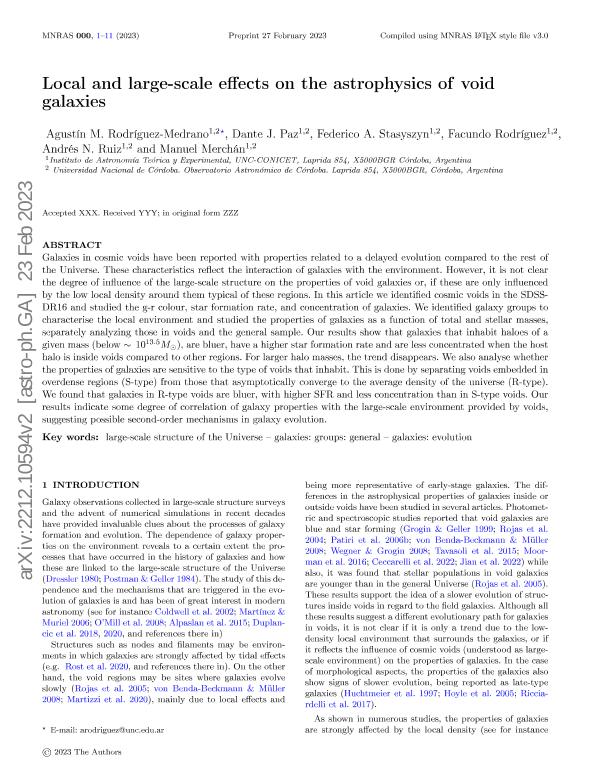Mostrar el registro sencillo del ítem
dc.contributor.author
Rodríguez Medrano, Agustín Miguel

dc.contributor.author
Paz, Dante Javier

dc.contributor.author
Stasyszyn, Federico Andres

dc.contributor.author
Rodriguez, Facundo

dc.contributor.author
Ruiz, Andrés Nicolás

dc.contributor.author
Merchan, Manuel Enrique

dc.date.available
2024-02-08T13:00:36Z
dc.date.issued
2023-02
dc.identifier.citation
Rodríguez Medrano, Agustín Miguel; Paz, Dante Javier; Stasyszyn, Federico Andres; Rodriguez, Facundo; Ruiz, Andrés Nicolás; et al.; Local and large-scale effects on the astrophysics of void galaxies; Wiley Blackwell Publishing, Inc; Monthly Notices of the Royal Astronomical Society; 521; 1; 2-2023; 916-925
dc.identifier.issn
0035-8711
dc.identifier.uri
http://hdl.handle.net/11336/226361
dc.description.abstract
Galaxies in cosmic voids have been reported with properties related to a delayed evolution compared to the rest of the Universe. These characteristics reflect the interaction of galaxies with the environment. However, it is not clear the degree of influence of the large-scale structure on the properties of void galaxies or if these are only influenced by the low local density around them typical of these regions. In this article, we identified cosmic voids in the SDSS-DR16 and studied the g–r colour, star formation rate, and concentration of galaxies. We identified galaxy groups to characterize the local environment and studied the properties of galaxies as a function of total and stellar masses, separately analysing those in voids and the general sample. Our results show that galaxies that inhabit haloes of a given mass (below ∼1013.5M☉), are bluer, have a higher star formation rate and are less concentrated when the host halo is inside voids compared to other regions. For larger halo masses, the trend disappears. We also analyse whether the properties of galaxies are sensitive to the type of voids that inhabit. This is done by separating voids embedded in overdense regions (S-type) from those that asymptotically converge to the average density of the Universe (R-type). We found that galaxies in R-type voids are bluer, with higher SFR and less concentration than in S-type voids. Our results indicate some degree of correlation of galaxy properties with the large-scale environment provided by voids, suggesting possible second-order mechanisms in galaxy evolution.
dc.format
application/pdf
dc.language.iso
eng
dc.publisher
Wiley Blackwell Publishing, Inc

dc.rights
info:eu-repo/semantics/openAccess
dc.rights.uri
https://creativecommons.org/licenses/by-nc-sa/2.5/ar/
dc.subject
EVOLUTION-GALAXIES
dc.subject
GALAXIES
dc.subject
GENERAL-LARGE-SCALE STRUCTURE OF UNIVERSE
dc.subject
GROUPS
dc.subject.classification
Astronomía

dc.subject.classification
Ciencias Físicas

dc.subject.classification
CIENCIAS NATURALES Y EXACTAS

dc.title
Local and large-scale effects on the astrophysics of void galaxies
dc.type
info:eu-repo/semantics/article
dc.type
info:ar-repo/semantics/artículo
dc.type
info:eu-repo/semantics/publishedVersion
dc.date.updated
2024-02-06T13:51:11Z
dc.journal.volume
521
dc.journal.number
1
dc.journal.pagination
916-925
dc.journal.pais
Reino Unido

dc.journal.ciudad
Londres
dc.description.fil
Fil: Rodríguez Medrano, Agustín Miguel. Consejo Nacional de Investigaciones Científicas y Técnicas. Centro Científico Tecnológico Conicet - Córdoba. Instituto de Astronomía Teórica y Experimental. Universidad Nacional de Córdoba. Observatorio Astronómico de Córdoba. Instituto de Astronomía Teórica y Experimental; Argentina
dc.description.fil
Fil: Paz, Dante Javier. Consejo Nacional de Investigaciones Científicas y Técnicas. Centro Científico Tecnológico Conicet - Córdoba. Instituto de Astronomía Teórica y Experimental. Universidad Nacional de Córdoba. Observatorio Astronómico de Córdoba. Instituto de Astronomía Teórica y Experimental; Argentina
dc.description.fil
Fil: Stasyszyn, Federico Andres. Consejo Nacional de Investigaciones Científicas y Técnicas. Centro Científico Tecnológico Conicet - Córdoba. Instituto de Astronomía Teórica y Experimental. Universidad Nacional de Córdoba. Observatorio Astronómico de Córdoba. Instituto de Astronomía Teórica y Experimental; Argentina
dc.description.fil
Fil: Rodriguez, Facundo. Consejo Nacional de Investigaciones Científicas y Técnicas. Centro Científico Tecnológico Conicet - Córdoba. Instituto de Astronomía Teórica y Experimental. Universidad Nacional de Córdoba. Observatorio Astronómico de Córdoba. Instituto de Astronomía Teórica y Experimental; Argentina
dc.description.fil
Fil: Ruiz, Andrés Nicolás. Consejo Nacional de Investigaciones Científicas y Técnicas. Centro Científico Tecnológico Conicet - Córdoba. Instituto de Astronomía Teórica y Experimental. Universidad Nacional de Córdoba. Observatorio Astronómico de Córdoba. Instituto de Astronomía Teórica y Experimental; Argentina
dc.description.fil
Fil: Merchan, Manuel Enrique. Consejo Nacional de Investigaciones Científicas y Técnicas. Centro Científico Tecnológico Conicet - Córdoba. Instituto de Astronomía Teórica y Experimental. Universidad Nacional de Córdoba. Observatorio Astronómico de Córdoba. Instituto de Astronomía Teórica y Experimental; Argentina
dc.journal.title
Monthly Notices of the Royal Astronomical Society

dc.relation.alternativeid
info:eu-repo/semantics/altIdentifier/url/https://academic.oup.com/mnras/article/521/1/916/7060394
dc.relation.alternativeid
info:eu-repo/semantics/altIdentifier/doi/http://dx.doi.org/10.1093/mnras/stad623
Archivos asociados
